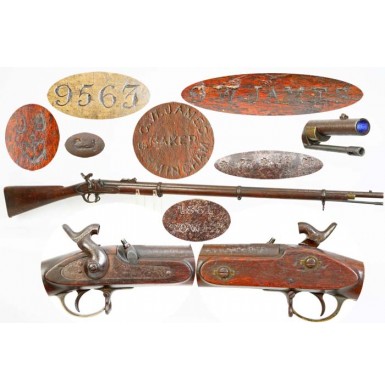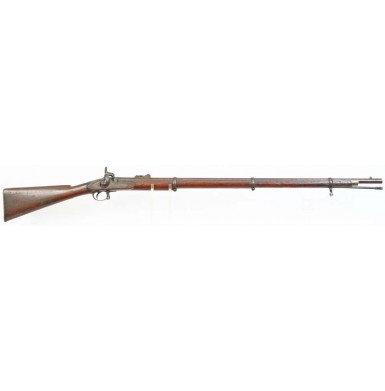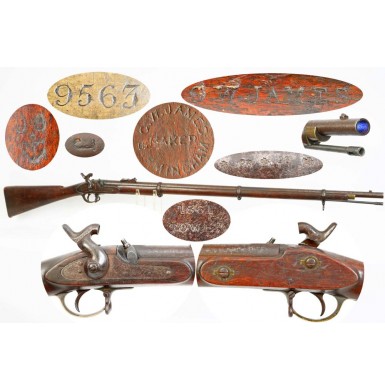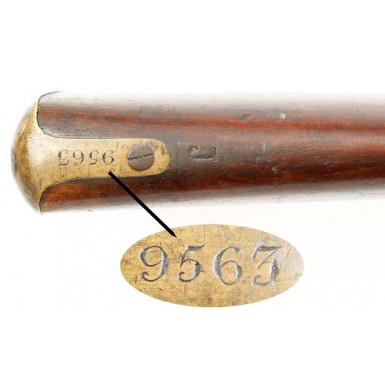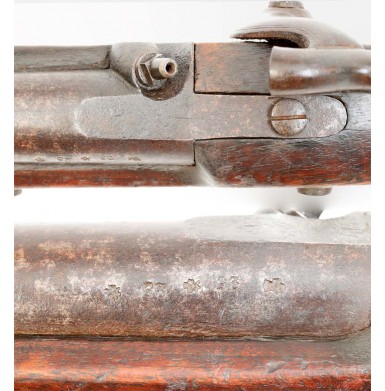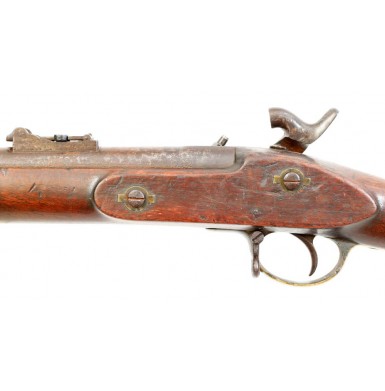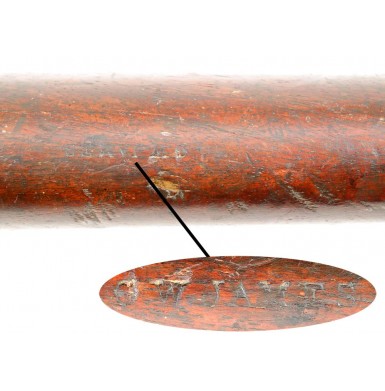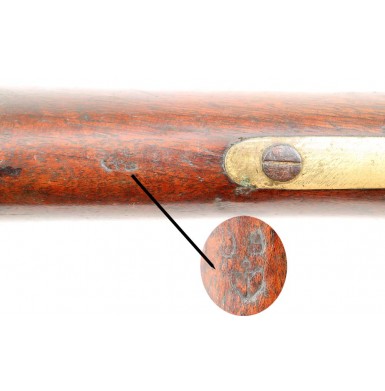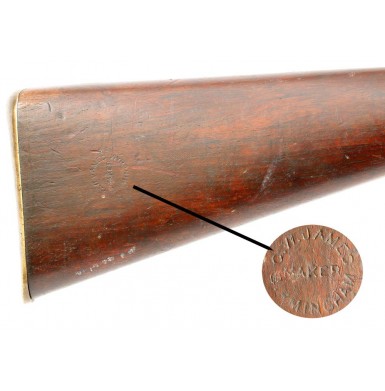Confederate JS/Anchor Marked & Inventory Numbered Enfield Rifle Musket
- Product Code: FLA-3140-SOLD
- Availability: Out Of Stock
-
$1.00
During the early days of the American Civil War, Confederate purchasing agents did a splendid job of tying up contracts for the British P-1853 Enfield Rifle Musket, which was truly one of the most advanced and well made military long arms of the day. According to Confederate Chief of Ordnance Josiah Gorgas’s February 3, 1863 summary of imported arms, some 70,980 “Long Enfield Rifles” were purchased from the beginning of the war through the end of 1862. These numbers only account for Confederate central government purchases, and do not include those P-1853s purchased by the individual Confederate states or by speculators seeking to sell them within the Confederacy. The majority of these arms were purchased from the firms of S. Isaac, Campbell & Company (who relied on John Edward Barnett & Sons to deliver many of those arms) or Sinclair, Hamilton & Company, who often routed their sales through S. Isaac, Campbell & Co as well. Additional P-1853s were purchased from William Grazebrook of Liverpool, who made his first sales to Confederate purchasing agent Caleb Huse within 30 days of the opening of the war. Sinclair, Hamilton & Company entered into several contracts with the Confederacy to deliver P-1853 Enfield Rifle Muskets, with the typical contract terms requiring 30,000 arms to be delivered over a six month period. During the course of the war, Sinclair, Hamilton & Company appears to have received at least five of these contracts for P-1853 Enfield Rifle Muskets from the Confederate central government. The second of these contracts for 30,000 P-1853 “Long Enfields’ is the one represented by the guns with the JS / (ANCHOR) mark, along with the engraved buttplate tang inventory numbers. These inventory numbers ran from 1-10,000 in three series (to date no gun with a 10,000 number is known, although theoretically they existed). The first series had no suffix after the number, while the second series of 10,000 had an “A” suffix under the inventory number and the third series of 10,000 had a “B” suffix. These numbered guns represent the October 1861 contract with Sinclair, Hamilton & Company that is referred to in Confederate documents as the “Second Contract”. This contract required the 30,000 Enfields to be delivered between October of 1861 and April of 1862. At least two identified “B” suffix guns with 3-digit inventory numbers have been determined to have been issued in Corinth, MS immediately prior to the battle of Shiloh on April 6-7 of 1862. Thus is it clear that the contract time line for production and delivery was closely followed, and the Confederacy did a good job delivering arms through the Union blockade during the first year of the war. Sinclair, Hamilton & Company acquired their arms through “Five Furnishers”. These were well-established gun making firms that were able to fill the large Sinclair, Hamilton & Company orders in a reasonable period of time. The “five furnishers’ were the long time London gunmakers EP Bond, Parker, Field & Sons, and James Kerr. Kerr apparently received a tiny portion of the contract (only 500 guns) due to his relationship with the London Armoury Company. Archibald Hamilton of Sinclair, Hamilton & Company was the managing director of The London Armoury Company, and James Kerr (of Kerr revolver fame) was London Armoury Company’s manager, having replaced his revolver designing rival Robert Adams in that position. The balance of the guns were delivered by the Birmingham based firms of C.W. James and W.C. Scott & Son. The furnishers often marked the guns that were delivered under this contract with a large single letter on the upper comb of the stock, just forward of the buttplate tang. The guns were marked with a B for Bond, an F for Parker, Field & Sons, a J for C.W. James, a K for James Kerr and an S for Scott & Son. A sixth single letter mark, P has been noted on extant Confederate Enfields from this contract. This mark was previously thought to be an alternate mark for Parker, Field & Company. However, more recent examination of extant examples and the other associated marks on those guns has revealed that this was the mark of Francis Preston of Manchester, England. Preston’s relationship within the contracting circle of the “five furnishers’ is not clear, but he delivered many socket bayonets for the numbered guns of this contract, and may have received a small sub-contract to provide long arms as well. No period documents have shown that Preston delivered the guns directly to Sinclair, Hamilton & Company, so it is most likely that his guns were sub-contracted by James or Scott, who delivered the majority of the guns. An October 31, 1861 dated letter from Sinclair, Hamilton & Co. notes that the contract was divided between the furnishers as follows: 8,000 guns from Scott & Son, 10,000 from CW James, 6,000 from E.P. Bond, 5,500 from Parker, Field & Sons and 500 from James Kerr. This indicates that the guns delivered by CW James (the largest supplier) represented about 33% of the total delivery under this contract, Scott & Sons about 25%, Bond about 20% and Parker, Field & Sons about 18% and the guns from Kerr represented less than 2% of the deliveries. An extensive database comprised of more than two decades of collected information related to Confederate purchased Enfields contains approximately 250 numbered P-1853 Enfield rifle muskets (not counting state purchased guns). Of those guns, the large majority (well more than half) are numbered guns with no suffix, representing about 74% of the recorded samples. A-suffix guns represent about 19% of the recorded examples, while B-suffix guns represent about 7% of surviving examples that are recorded. To date, less than 50 A-suffix and less than 20 B-suffix P-1853 Enfields are known to exist. The reason for the paucity of these arms is not clear, but it may simply be the result of attrition and the arms having been used up. With B-suffix guns (which would have theoretically been delivered later than the no suffix or “A” guns), the lack of extant examples may be an indication of the early successes experienced by the Union’s Atlantic Blockading Squadron. Recorded numbers show a good distribution of engraved numbers from two digits through the mid 2XXX range. Then there is then a nearly 4,000 number gap in the database that seems to indicate that a large number of the “B-guns’ in the 25XX to 62XX range may well be on the bottom of the Atlantic ocean. “A suffix” guns, although uncommon and with few examples to study, show a nice even distribution through the entire numbering sequence. This suggests that their scarcity today is the result of them having seen hard use, rather than having been dumped overboard while a Confederate blockade runner tried to elude a pursuing US Naval vessel.
The P-1853 Enfield Rifle Musket offered here is a classic example of a Confederate marked and imported musket that clearly saw use in the field. The gun is in about NEAR FINE condition, especially for a Confederate purchased and used gun that was probably delivered no later than the first quarter of 1862. The gun retains a very legible J S / (ANCHOR) mark in the wood behind the trigger guard, along with the name of the guns master contractor C W JAMES. The obverse butt is also stamped with the James maker’s cartouche, which reads C. W. JAMES / BIRMINGHAM in a circle around the word MAKER. The buttplate tang is engraved with the inventory number 9563, indicating that this gun was delivered at the end of the first group of 10,000 muskets to be delivered under the 2nd Sinclair, Hamilton & Company contract. Based upon a study of extant examples, their inventory numbers and the lock dates on the Birmingham made guns, this rifle musket was likely produced in very late 1861 and delivered by early 1862. The gun bears a very crisp J furnishers mark, indicating that is was delivered to Sinclair, Hamilton & Company by C.W. James of Birmingham. The firm of Charles W. James was established at 6 Bath Street in Snowhill, Birmingham, in 1859. In 1862 as the firm expanded it moved to 36 & 37 Loveday Street, St. Mary’s, Birmingham. A period advertisement listed the company as being “MILITARY ARMS CONTRACTOR TO THE WAR DEPARTMENT”, as well as being a maker of “SINGLE & DOUBLE BARRELED GUNS, PISTOLS, RIFLES, AND OF THE MOST IMPROVED BREECH-LOADERS, ALSO Guns for the African and other Foreign Markets”. Period documents suggest a strong business relationship between C.W. James and the two gunmaking Bond brothers, Edward Philip (E.P.) Bond of London and Eyton Bond of Birmingham. In addition to be the contract to provide the arms to the Confederacy under the 2nd Sinclair Hamilton contract (10,000 or 1/3 of the contract), James also provided arms to the state of Georgia as part of the 5,000 P-1853s contracted for by that state. James received an additional order for 10,000 P-1853s from Sinclair, Hamilton & Company, dated October 31, 1863. This order was probably part of the 4th or 5th Sinclair, Hamilton & Company contract. The firm went out of business in 1866, suggesting that James’ prolific production and close ties to the Confederacy left him bankrupt when his southern buyers were not able to pay their bills when the fortunes of war collapsed for the south. Although James produced more of the numbered Enfields from the 2nd Sinclair, Hamilton & Company contract than any other furnisher, his arms do not represent the largest number of known examples and tend to be no more common than any of the other furnishers, with the exception of the rarely encountered arms furnished by James Kerr.
As previously noted, this Confederate inspected and numbered P-1853 Enfield Rifle Musket is in NEAR FINE condition, and is 100% complete and correct, with the exception of a period replaced ramrod. The lock is marked in two lines, forward of the hammer, 1861 / TOWER, wit the typical British “Crown” mark to the rear of the hammer. The gun is a typical commercial one and bears no British military marks at all, which is typical of guns bound for export markets. The upper left of the breech is marked with the usual post-1813 Birmingham commercial Provisional View, Definitive View and Proof marks, with a pair of 25 gauge marks in between the other proofs, indicating the gun is .577 caliber. The interior of the lock is clearly marked with a (CROWN) / JB over the mainspring, with the name SIDDONS around the mainspring boss stud. This is the mark of Birmingham gunlock maker William Siddons, who produced some of the finest gunlocks in England during the mid-19th century. William Siddons established his firm in 1817 on Whittall Street in that year. In 1855 the firm became William Siddons & Sons. In 1863 the company moved to 16 St. Mary’s Row and in 1864 to 18 & 19 Weaman Row. William Siddons Junior succeeded to the business in 1866 and the firm ceased operations in 1868. Siddons was intimately involved with Birmingham’s premier gunmaker Thomas Turner, and his locks are often encountered in Turner’s higher-grade guns, especially those meant for target shooting. Siddons was granted British Patent #1789 (1854) for a friction reducing lock that had the tumbler and mainspring function upon knife-edges, and his son received a patent in conjunction with Thomas Turner (#2227 of 1866) for the design of a breechloading gun action. Siddons locks are considered some of the highest quality locks of the era and were greatly prized by the shooters lucky enough to have a gun with one of his locks. The mainspring boss itself is stamped JH, which is probably the mark of the “setter up” who assembled the gun. This mark is found elsewhere on the gun as well. The top edge of the lock is stamped with the Arabic number 7, and the assembly number “7” is found throughout the gun in a combination of both Arabic and Roman numerals. The bottom of the barrel is marked with the name of the barrel maker, BURR. The Burr family was a well-established gun-barrel making concern in Rowley Regis, Staffordshire. The family worked in the Hayseech Mill Works area of Old Hill from 1849-1872, first as Burr & Son and later as Burr Brothers. The barrel is also marked with the initials JH and the assembly number 7. The mark JH 7 is also found on the rear of the breech plug. The barrel of the gun is primarily a medium plum brown mottled patina with traces of original rust blued finish and scattered patches of light surface oxidation as well as areas of scattered surface roughness. The bottom of the barrel retains about 40% of its original rust blued finish, which is also mixed with an oxidized patina, patches of oxidized roughness and some surface scale. The appearance of both the top and bottom of the barrel suggest that it was never cleaned, and remains in essentially untouched condition from the period of use. The breech shows some light pitting and oxidized surface roughness from the percussion cap flash, and there is some lightly scattered pinpricking and minor pitting along the length of the barrel as well. The bore of the musket is in about GOOD condition. The bore is very dark and dirty with a rusty appearance that could probably be improved with a serious scrubbing and cleaning. The bore retains visible 3-groove, progressive depth rifling that appears fairly weak closest to the muzzle and improves closer to the breech. The barrel bands have a nice, untouched plum brown patina, and all match each other very well and the barrel of the gun very well. All three of the barrel band screws retain the “doughnut” shaped keepers on their end, which are usually missing. All of these keepers appear to be original to the musket. The gun retains what appears to be its original sling swivels on both the upper barrel band and on the bow of the trigger guard. The action of the gun is mechanically excellent and functions crisply on all positions. As would be expected of a Siddons patent lock, the function is quite smooth. The lock has the same chocolate to mottled plum and brown patina as the rest of the gun, with some darker mottling, suggesting minor traces of the original case colored finish. The lock markings are quite crisp and legible, although the lock does show some very lightly scattered pin pricking and oxidized crust on its surface. The brass furniture has a nice, untouched, dark umber patina, which is very attractive, with only the rear tang of the triggerguard showing a slightly brighter color, probably from handling over the years. The Confederate inventory number 9563 is neatly engraved on the tang, and the furnisher letter J is neatly stamped in the wood forward of the tang. The original long-range rear sight is complete and fully functional. The original front sight/bayonet lug is present near the muzzle of the musket. The original ramrod, which was numbered to the gun, is missing in action. This is typical with numbered Enfields, as less than 10% of extant examples retain a numbered ramrod (let alone the original matching one). The ramrod that now accompanies the gun is an original, period rod of P-1853 pattern and has a deep brown patina that matches the balance of the gun well. It is essentially full-length but has no threads at the end and appears to be a blacksmith repaired ramrod, with cruder section welded to the front portion of the rod. The rod is very thick and fits in the ramrod channel VERY tightly, requiring the loosening of the bands and the use of a tool in the jag head in order to remove it from the ramrod channel. This extremely tight fit is probably a combination of the shrinkage of the wood over time and the repair to the rod. This problem may have been somewhat of an issue in the period, as the rammer retention spoon has been removed from the stock, and the pin that holds it replaced. This suggests the problem was old and was dealt with as best as possible during the period. Thousands of replacement Enfield ramrods were imported thought the Confederate port of Wilmington, NC between 1863 and 1864, suggesting the breakage and loss of rammers in the field was a constant problem. The stock is in about FINE condition overall. The stock is solid, complete and full-length, with no breaks, cracks or repairs noted. The stock remains crisp and sharp throughout with on indications of having ever been sanded. The stock does, however, show numerous scattered bumps, dings, rubs and mars, as would be expected from a 150+ year-old military arm. The stock also shows a few minor splinters out of the rammer channel and small chip of wood missing from the rammer channel behind the nose cap. This is all old, period of use damage, typical of a muzzle loading military musket. As noted previously, the stock retains a crisp and clear JS / (ANCHOR) inspection stamp in the wood behind the trigger guard, as well as a very legible C W JAMES maker mark in the toe of the stock. The obverse buttstock also bears a clear CW James maker’s roundel that reads C. W. JAMES / BIRMINGHAM in a circle around the word MAKER.
Overall this is a really wonderful example of a Confederate inspected and numbered P-1853 Enfield Rifle Musket by one of the most prolific of the Birmingham contractors to supply the Confederacy. The gun retains very nice maker marks throughout, with the James name clearly visible on the obverse butt and in the toe of the stock. The musket retains a very clear example of the most desirable and well known of Confederate import marks, the JS / (ANCHOR). It also has a wonderful engraved inventory number on the brass buttplate along with a legible furnisher’s mark on the stock as well. This gun was clearly a very early arrival in the Confederacy that was likely on the field well before the beginning of the 1862 spring and summer campaign seasons. Less than 1% of the 30,000 guns from the 2nd Sinclair, Hamilton & Company contract are known to have survived to be in collections today, this is simply an incredibly scarce example of a Confederate purchased gun. If you have ever wanted to own a completely honest example Confederate used P-1853 Enfield Rifle Musket, that really saw service and fought the war, yet managed to escape modification and cleaning in the years after war, this would be a good addition to you collection. This is a very nice example of an unmolested Confederate Enfield, which is very hard to find these days, and would be difficult to upgrade without spending significantly more money.
SOLDTags: Confederate, JS, Anchor, Marked, Inventory, Numbered, Enfield, Rifle, Musket

